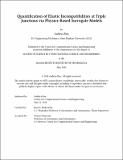Quantification of Elastic Incompatibilities at Triple Junctions via Physics-Based Surrogate Models
Author(s)
Rau, Aaditya
DownloadThesis PDF (8.323Mb)
Advisor
Radovitzky, Raul A.
Terms of use
Metadata
Show full item recordAbstract
Stresses at grain boundaries resulting from elastic incompatibilities have long been known to drive the premature failure and loss of desirable macroscopic properties in polycrystalline materials. As a result, there have been significant efforts in the field of grain boundary engineering to understand the sources of grain boundary incompatibilities in polycrystals and potential mitigation strategies through microstructure manipulation. Thus, understanding the relationship between grain incompatibility and failure is important for the practical use of polycrystalline materials. Surrogate models based on machine learning methods have gained broad popularity due to their ability to furnish a functional, albeit approximate, description of complex phenomena. The goal of this thesis is to predict quantitative metrics of incompatibility from various triple junction configurationsusingasurrogatemodel. High-fidelityfiniteelementsimulationsofacubic-crystal triple junction under hydrostatic extension were used to generate a synthetic dataset for training the surrogate model. A set of 𝐽 integrals computed around microcracks placed along the triple junction boundaries were used to quantify the elastic incompatibilities between the grains. A multi-layer perceptron network was trained using the grain rotation angles and 𝐽 integrals as the feature and label data respectively. We demonstrate that the trained network establishes an accurate functional dependence between the triple junction angles and the 𝐽 integrals. We use the surrogate model to efficiently sweep the configuration space and create contour maps of the largest stress intensification at the triple junction as a function of the grain rotation angles. Furthermore, we show that the surrogate model can be utilized to identify the most and least compatible triple junction configurations via optimization. These configurations are then compared to those identified as favorable through the theory of coincident site lattices.
Date issued
2024-05Department
Massachusetts Institute of Technology. Center for Computational Science and EngineeringPublisher
Massachusetts Institute of Technology